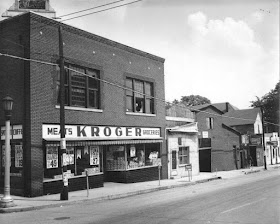If Paul Hadley titled this painting, it has been lost to history.
Untitled Painting
by Paul Hadley
Given that Hadley never drove motor vehicles, he hiked (or occasionally was driven over long distances by friends) around Morgan County to paint many choice landscapes. This makes it reasonably likely that the location of this untitled painting was within walking distance of his home on East South Street in Mooresville. It was probably somewhere between Washington Street to the north, and South Street to the south, of town. Admittedly, that pretty much encompassed all of Mooresville before World War II, so it doesn't narrow the field by much.
When Hadley wanted to paint landscapes further afield than the surrounding counties, he travelled by bus or by railroad, or sailed overseas on passenger liners.
Hadley painted what interested him; he was totally unconcerned with his work's market value. He sold his paintings cheaply, because he knew that many of his buyers, with whom he was most often acquainted, could afford only bargain prices. Oftentimes, he simply gave away his paintings as gifts or as payment for someone's business advice or a favor.
Not that Hadley was dependent upon the income his artwork produced. He was an accomplished interior designer, having trained in a Philadelphia studio in which he specialized in stained glass design. He worked for a Chicago interior design firm and earned commissions for his many projects. Most famously, Hadley designed the Kennebunkport, Maine residence of Hoosier author Booth Tarkington. In 1933 the Indiana Commission for the Century of Progress Exposition asked Hadley to design the benches for the Indiana pavilion for the Chicago World's Fair.
Hadley also was an instructor at the Herron Art Institute in Indianapolis. He taught interior design and watercolor painting. In 1933, when cutbacks eliminated several teaching positions at Herron, Hadley became assistant curator for the institute's museum (1932-1936).
Hadley also operated an art studio in Indianapolis, which attracted many clients, especially among the city's burgeoning cultural class. His watercolors were much in demand. All of these professional ventures assured Hadley a reasonable income.
If we were to attempt to locate the place Hadley painted the untitled watercolor above, we would need to walk the streets and alleys of Mooresville to see if the structures shown still stand. Given that they appear to have been outbuildings, they are probably no longer extant, as most of these were removed as older town lots were converted to more modern residences, rather than as miniature family "farms" (townsfolk routinely kept livestock on residential lots well into the 20th century). We have looked far and wide but have seen nothing still standing that looks quite like Hadley's portrayal.
Regardless, the painting has a warmth and charm typical of Hadley watercolors. Dilapidated buildings never looked ugly in a Hadley painting; rather, they exuded a beauty despite their collapsing or antiquated condition. This was what distinguishes a Hadley painting--behind the simplicity of form and technique lurked the inherent beauty in every subject.
Be sure to visit the library personally to see Paul Hadley's paintings. They are exhibited in our grand hall along the wall that separates the vending machine area.




















































